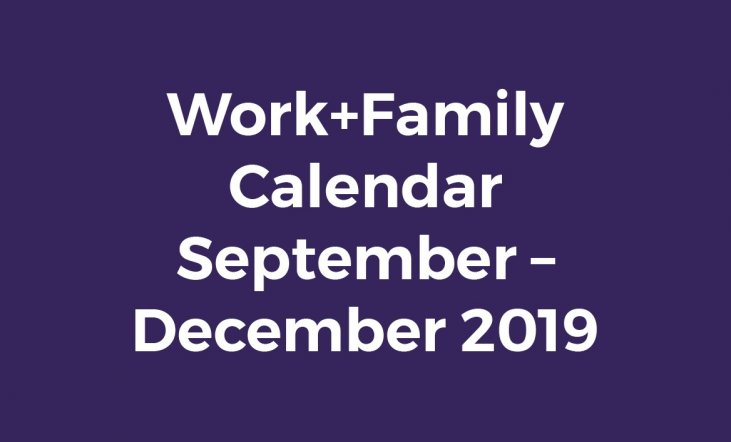Newsletter Sign Up
Regular work+family updates for
HR and diversity professionals.
My Family Care asks Fiona: Flexible working seems to be the way of the future, but how are companies dealing with requests and what advice do you have for others who want to work flexibly?
Wellbeing and retention
Flexible working is a hot topic for employers, driven by an awareness that, as work becomes all-consuming in the modern world, we need to be proactive about looking after our own wellbeing.
What's more, companies also realise, in order to retain valuable staff and attract the best talent out there, they need to embrace flexible work practices - options that enable people to nurture other aspects of their lives alongside their careers, be it family, leisure, caring responsibilities or contributing to causes they're passionate about.
With over twenty years' experience in the HR and recruitment industry, and as an executive committee member of the NSW Equal Employment Opportunity Practitioners' Association, I'm a passionate advocate for flexibility in the workplace. As a Director of, and Diversity and Work-life Integration Specialist, at SeventeenHundred, I support organisations as they work towards creating flexible workplace practices for their employees.
Workplace flexibility trends - Australia and abroad
1. Embracing across-the-board flexibility
Instead of tinkering around the edges of existing policies, companies are starting to disrupt the status quo of the traditional 36.75 hour week by offering a wide range of flexible options to all employees - not just some.
An example is Telstra's 'All Roles Flex' policy: every job within the company is open to flexibility, be it part-time work, different hours, working from home, and more. It's interesting to note that since starting the policy in 2013, the number of women joining the company has exceeded the number leaving for the eighth consecutive quarter, reversing a long-running trend.
2. Flexibility for men and women
Discussions around workplace flexibility now include men, not just working mothers. According to a survey by the Boston College Centre for Work & Family, the most frequently cited need by Australian fathers is flexible work arrangements.
Research also shows that giving men the opportunity to work flexibly not only enables mothers to return to work, but is also a positive experience for children. The Workplace Gender Equality Agency has addressed this issue with the Equilibrium Man Challenge: an initiative featuring men who are searching for ways, such as working flexibly, to be active in both their children's lives and their careers.
3. Flexibility for reasons outside of parenting
Many Australian businesses are coming to SeventeenHundred looking for a better approach to assisting employees with carer responsibilities. It's clear companies are starting to recognise the many other reasons workers need flexibility - besides childcare - such as caring for elderly parents, doing volunteer work, travelling, tending to health issues, or pursuing an elite sport.
Employee considerations
So if you want to work flexibly, what's the best way to approach this with your employer? Here are some points to consider:
- Communicate your needs to your manager and enter into the discussion prepared. Some points to consider prior to any conversation are: why you want to work flexibly; what work arrangement you want to propose; how long you will require it for; what elements of your job may be affected by working flexibly and any possible solutions. It's also important to know what you are legally entitled to when making requests.
- Keep an open mind about what is possible. Enter into discussions willing to consider a number of different work arrangements, not just the one you are proposing.
- Glean wisdom from mentors who have already walked the path. For example, if you're a dad considering working flexible hours to better care for your family and are unsure of how this will work, speak to a senior member of staff who has done something similar and learn from their experience.
The employer perspective
As for employers who seek to build a flexible work culture within their organisation, here are some tips:
- Have a formal approach. Organisations that implement formal flexible work practices, with guidelines for managers, will achieve stronger results and better business outcomes than just relying on informal practices. Consistency is important so there is no stigma associated with who is allowed to work flexibly.
- Build an emergency response. This might mean building redundancy into workloads so the business isn't relying on an individual for critical tasks, leaving them conflicted if a personal crisis or emergency occurs.
- Create a culture where people are not just permitted, but encouraged, to make use of flexible work policies. Communication of flexible work options is key here, as well as using organisational case studies to demonstrate that individuals can still progress with their careers when taking a flexible option.
- Have a return-to-work coaching program. In the case of paid parental leave, helping parents handle the practical and emotional aspects of transitioning back to work enables them to develop in their post-parental leave career. It also will produce stronger results if/when those employees choose to access flexible work options, moving forward.
Fiona Hitchiner, Director, and Diversity and Work-life Integration Specialist












